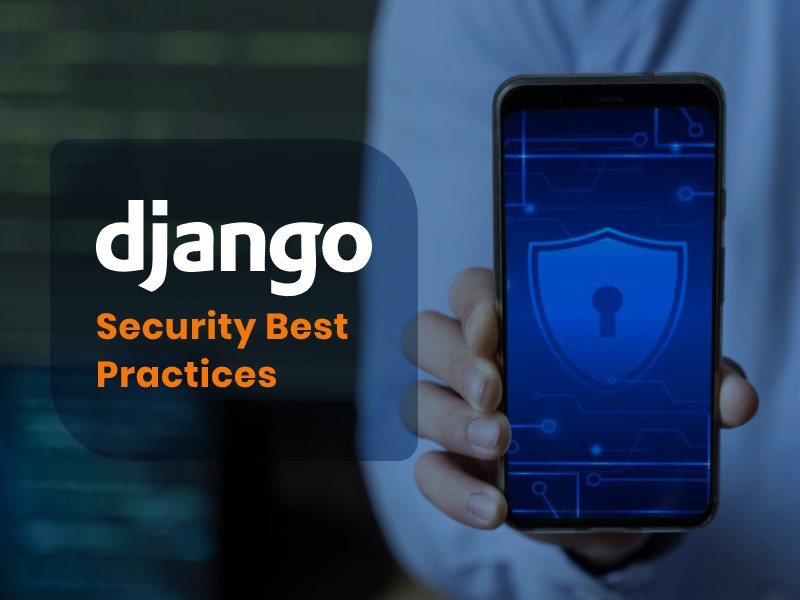Why Should you Consider Django Security When Building Applications: Top 18 Best Practices with use Cases

Lately everyone from individuals, to small businesses to large corporations has been a target of cyberattacks. Back when the world was not as digitized as it is now, the picture was not always the same. Small and midsize businesses (SMBs) were not much conscious about cyberattacks as their dealings were mostly manual.
However, with the increasing digitization, businesses of every size are exposed to threats of cyberattacks and data breaches; the data from AV-TEST Institute reinstates this. According to this Germany-based independent IT security research institute, registration of approximately more than 450,000 new malicious programs (malware) and potentially harmful applications (PUA) are recorded every day.
Let us explain the severity of the situation with a real time example. Consider that you are a medical service provider where you deal with enormous amounts of personal data of our customers.
Now imagine the consequence if the Django-allauth authentication library of your Django project is found vulnerable to a Cross Site Request Forgery (CSRF) attack.
Cyber criminals can exploit this weakness to trick users into performing unintended actions. Hackers will send the victim a malicious link or form that will have a hidden CSRF token and the moment the victim clicks on the link or submits the form, the CSRF token will be submitted to the server along with the rest of the form data. The server will then use the CSRF token to authenticate the request, even though it was not actually initiated by the victim.
Similarly Cross-Site Scripting (XSS) attacks on Django based apps are also on rise these days. These categories of digital crime involve injecting malicious code into the framework, which can then be executed by the victim’s browser. XSS attacks can cause multiple problems with your system such as stealing of cookies or session tokens, or redirecting your customer to a duplicate malicious website to steal their personal data.
Financial implication of gaps on your Django Application
With the aim of improving their digital footprint, businesses frequently use engaging and customer friendly front-end and a back-end framework. Most businesses further invest in resources that create visually appealing, seamless user experiences wherein cyber security often takes a backseat and becomes vulnerable. This can result in severe financial, regulatory, and reputational consequences.
The financial implication of cyber thefts has been estimated in a report by McKinsey. Published in 2014 the report on enterprise IT security projected that the global economy would incur a cost of approximately $3 trillion by 2020 due to poor cybersecurity.
The financial implications of lax cybersecurity are quite evident from prominent cyberattacks that happened lately, such as the Equifax data breach which is projected to have exposed sensitive personal and financial information of 56% of Americans. The estimate of this digital crime is approximately $1.4 billion including the legal and investigation expenditures.
And don’t forget the NotPetya ransomware attack? It also caused companies worldwide to lose approximately $1.2 billion. In addition to money, cyber breaches additionally lead to identity theft from stolen credentials, unpatched software, exploitation of zero-day vulnerabilities, and malfunctioning servers.
In the following part of the article, we will discuss some security tips that you can deploy on your application framework. We have focused on Django web framework because it is widely used for Python applications and is known for its user friendly coding.
Security Best Practices for Django applications
Building applications with Django is an appealing prospect, but securing it is equally important. Follow these useful tips to safely guard your Django applications.
1. Keep Django Up to Date
One of the foundational steps in ensuring the security of your application is to keep the framework itself up-to-date. The Django development team regularly releases updates and patches to address security fallouts and bugs. By using the latest version of Django web framework, designed by a trusted software development agency you can benefit from the latest security enhancements and ensure that your application is protected against known mal activities.
2. Implement Strong Authentication and Authorization
Authentication and authorization mechanisms are the first line of defense against unauthorized access to your Django app. Utilize Django’s built-in authentication system, which provides features such as user authentication, password hashing, and session management.
Next, implement role-based access control (RBAC) to ensure that users only have access to the parts of the application that are relevant to their roles and responsibilities. Use strong password policies and encourage users to create complex passwords. Implement multi-factor authentication (MFA) wherever possible to add an extra layer of security to user accounts.
3. Secure Configuration Management
Sensitive information such as database credentials, API keys, and secret keys should never be hard-coded in your source code. Utilize Django’s settings module to store and manage configuration variables. Consider using environment variables or a configuration management tool to handle sensitive data, keeping them separate from your codebase and protected from unauthorized access.
Follow the principle of least privilege when granting permissions to access configuration files. Regularly review and audit your application’s configuration to ensure that no sensitive information is exposed.
4. Protect Against Cross-Site Scripting (XSS) Attacks
Cross-Site Scripting (XSS) attacks occur when an attacker injects malicious scripts into the application, which are then executed in the context of a user’s browser. To prevent these attacks, Django offers template escaping by default, which automatically escapes variables in templates to prevent them from being interpreted as executable code.
Additionally, be cautious when using user-generated content in your templates and validate and sanitize any inputs. Regularly audit and sanitize user inputs before rendering them in templates or serving them to users. Consider using security libraries, Django documentation and frameworks that provide additional protection against Cross-Site Scripting attacks.
Also Read: Evaluating Django Packages
5. Prevent Cross-Site Request Forgery (CSRF) Attacks
Cross-Site Request Forgery (CSRF) attacks involve tricking a user into unknowingly executing actions on the Django template without their consent. Django provides protection against CSRF attacks by generating unique tokens for each form rendered in templates.
Ensure that type of protection is enabled in your forms and utilize the {% csrf_token %} template tag to include the CSRF token in your forms. Regularly test your application’s forms to ensure that the protection is effective. Use the Django Debug Toolbar or other similar tools to identify and make the Django admin more secure.
6. Sanitize User Input and Use Prepared Statements
When dealing with user inputs, ask your django development services provider to validate and sanitize the data before using it in your application. Use Django’s form validation features to ensure that user inputs adhere to the expected format. Additionally, when interacting with databases, use prepared statements and parameterized queries to prevent SQL injection attacks, which occur when malicious SQL statements are injected into input fields.
Educate your development team about the risks of SQL injection and provide training on secure coding practices. Implement code reviews to catch potential early in the development process.
7. Implement Content Security Policy (CSP)
Content Security Policy (CSP) is a security feature that helps mitigate the risks of cross-site scripting and other code injection attacks. By specifying which sources of content are allowed to be loaded, you can prevent malicious scripts from executing. Implement CSP in your Django app by configuring the appropriate HTTP headers or using third-party middleware.
Regularly review and update your CSP policies to adapt to changes in your application’s content sources and security requirements. Use CSP reporting mechanisms to receive notifications about policy violations.
8. Regularly Backup and Monitor Your Application
Frequent data backups are essential in case of data loss or security breaches. Implement automated backup processes to ensure that your application’s data is regularly backed up and can be restored if needed. Also, set up monitoring and logging mechanisms to detect and respond to unusual activities or security incidents promptly.
Define incident response procedures and conduct regular drills to ensure that your team knows how to respond effectively to security incidents. Utilize intrusion detection systems and security information and event management (SIEM) tools to enhance your monitoring capabilities.
9. Use HTTPS Everywhere
Encrypting data in transit is paramount to maintaining the confidentiality and integrity of user information. Secure your Django app by using HTTPS (SSL/TLS) for all communication between clients and servers.
Obtain an SSL certificate from a reputable certificate authority and configure your web server to enforce HTTPS connections. Regularly renew SSL certificates before they expire and keep track of the latest encryption standards and protocols to ensure that your application remains secure against emerging threats.
10. Employ Security Testing
Regular security testing is crucial for identifying weaknesses in your Django or Python app. Conduct thorough security assessments, including penetration testing and frailty scanning, to uncover potential entry points for attackers.
Automated tools and manual testing can help ensure that your application is resilient to various types of attacks. Integrate security testing into your continuous integration and continuous deployment (CI/CD) pipeline. Consider using tools like OWASP ZAP, Burp Suite, and static code analysis tools to identify and remediate security issues.
11. Limit Error Information Disclosure
When errors occur, avoid displaying detailed error messages to users, as these messages might reveal sensitive information about your application’s structure and technologies. Instead, create custom error pages that provide minimal information and guide users on what to do next. Additionally, log errors securely, and avoid exposing stack traces in production environments.
12. Secure Third-Party Packages
Web development with Django often relies on third-party packages and libraries. However, it is essential to ensure that these dependencies are secure and well-maintained. Regularly update third-party packages to their latest versions, as they may contain security fixes. Use reputable sources for package installation and consider using tools like Pipenv or Virtualenv to isolate your application’s environment.
13. Secure API Endpoints
Modern Django and other top Python frameworks often rely on APIs to communicate and exchange data with other services. When building APIs for your Django app, ensure that you implement proper authorization mechanisms.
Use tokens or API keys to control access to your endpoints and enforce rate limiting to prevent abuse. Implement input validation and serialization to prevent malicious data from entering your application through API endpoints. Consider using API versioning to maintain backward compatibility and avoid security gaps arising from outdated API versions.
14. Implement Data Encryption
Protecting sensitive data, both at rest and in transit, is crucial for maintaining the confidentiality of user information. Utilize encryption algorithms to encrypt data before storing it in databases. Django provides tools and libraries for encryption, such as the django-cryptography package, which simplifies the process of encrypting sensitive fields in your models.
It is important that you use encryption protocols like TLS/SSL to secure data as it travels between the client and the server. Ensure that your application’s encryption protocols adhere to the latest security standards and recommendations.
15. Harden Your Server Configuration
The security of your Django app isn’t limited to the application code itself; the server environment also plays a significant role. Implement server hardening practices to minimize potential attack vectors. Disable unnecessary services and ports, use firewalls to restrict incoming traffic, and regularly update the server’s operating system and software components.
Consider using security headers such as HTTP Strict Transport Security (HSTS), X-Content-Type-Options, and X-Frame-Options to bolster the security of your application. Use a Web Application Firewall (WAF) to filter out malicious traffic and protect your application from common attacks.
16. User Input Validation
Validating user input is a fundamental security practice that helps prevent a wide range of attacks, including SQL injection, cross-site scripting, and command injection. Use Django’s built-in form validation and model field validation to ensure that user inputs conform to expected formats and values. Implement input validation on both the client and server sides.
Utilize regular expressions and validation libraries to thoroughly validate user inputs and reject any input that doesn’t meet specified criteria.
17. Continuous Security Training
Maintaining a security-aware development team is key to enhancing security in Django. Provide regular security training to your developers, educating them about the latest threats, attack vectors, and security tactics.
A well-informed team is better equipped to identify and address potential security weaknesses during the development process. Encourage developers to stay engaged with the broader security community by attending conferences, participating in security-focused forums, and following reputable security blogs and publications.
18. Secure Development Lifecycle
Integrate security into every phase of your application’s development lifecycle. Implement security reviews and assessments during design, coding, testing, and deployment stages. Use tools like threat modeling to identify potential security risks early in the development process and devise mitigation strategies.
Use Cases for Security Best Practices in Django Apps
Now, let’s explore some real-world use cases that highlight the significance of the above mentioned Django security tips in your web applications:
1. E-Commerce Platforms
Use Case: Imagine you have hired a Python web development company to do a Django project in the e-commerce industry. Your application handles a significant amount of sensitive customer information, including personal details and payment data. Here are some security tips for the situation:
· Data Encryption: Implement end-to-end encryption to protect customer data during transmission. Utilize Django’s tools to encrypt sensitive data before storing it in the database..
· Secure Authentication: Implement strong user authorization to prevent unauthorized access to user accounts. Enforce password policies and consider multi-factor authentication for added security.
· Regular Updates: Keep Django and third-party packages up to date to benefit from the latest security patches. Regularly review and update your application’s security measures.
2. Healthcare Management System
Use Case: You’re developing a healthcare management system that stores patient records, medical history, and treatment plans, and data integrity and confidentiality are critical. Here are some security tips for the situation:
· Role-Based Access Control (RBAC): Implement RBAC to ensure that healthcare professionals can only access patient data relevant to their roles. This prevents unauthorized users from accessing sensitive medical information.
· Auditing and Logging: Implement auditing mechanisms to track who accessed patient records and when. Log access and modification attempts to facilitate forensic analysis in case of security incidents.
· Content Security Policy (CSP): Prevent cross-site scripting attacks by using CSP to control which scripts can be executed on your application’s pages.
3. Financial Management Application
Use Case: Your Django app serves as a financial management tool for individuals and businesses, allowing them to track expenses, manage budgets, and monitor transactions. Here are some security tips for the situation:
Security Tips:
· Secure Data Storage: Apply encryption techniques to store sensitive financial data, such as transaction histories and account balances. Utilize Django’s built-in security features to protect stored information.
· CSRF and XSS Prevention: Implement CSRF protection to prevent attackers from exploiting users to perform unauthorized actions. Utilize template escaping and input validation to prevent cross-site scripting attacks.
· Input Validation: Thoroughly validate user input before processing it. Implement strong validation mechanisms to prevent injection attacks that could compromise financial data.
4. Educational Platform
Use Case: You’re developing an online education platform using Django, which hosts course content, student profiles, and assignments. Here are some security tips for the situation:
· Authentication and Authorization: Ensure only registered students and educators can access course materials. Implement fine-grained authorization to restrict access to specific content based on user roles.
· File Upload Security: Implement secure file upload mechanisms to prevent malicious files from being uploaded to your platform. Utilize Django’s file handling features and implement strict file type validation.
· Secure Session Management: Implement secure session management to protect user sessions from being hijacked. Use Django’s built-in session management features and enforce session timeouts.
5. Social Networking Site
Use Case: You’re building a social networking site with Django, where users can create profiles, connect with friends, and share content. Here are some security tips for the situation:
· Privacy Controls: Implement robust privacy settings that allow users to control who can see their content. Ensure that user data is only shared according to users’ preferences.
· User-Generated Content: Implement strict validation and sanitization for user-generated content to prevent cross-site scripting and other content-related attacks.
· API Security: If your platform offers APIs for third-party integration, implement strong authentication mechanisms and rate limiting to prevent abuse and unauthorized access.
Wrapping Up
Security is a continuous journey, and it’s essential to remain vigilant in the face of evolving threats. By adhering to these tips on Django security best practices, developers can create applications that not only deliver exceptional user experiences but also prioritize the safety and security of user data.
Remember that security is a collaborative effort involving developers, system administrators, and stakeholders. Regularly reassess your security strategies, stay informed about emerging threats, and adapt your practices accordingly. By adopting a comprehensive and proactive security approach, you can ensure that your applications based on the Django framework remain resilient in the face of an ever-changing threat landscape.
If you have any queries regarding Django web development or securing it, feel free to connect with our development experts or or mail us at [email protected].


